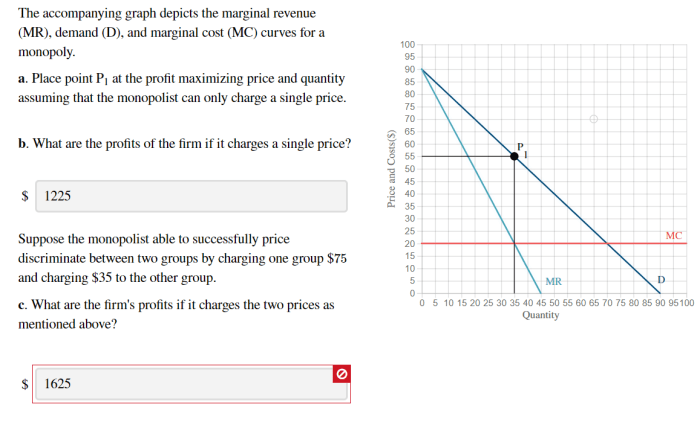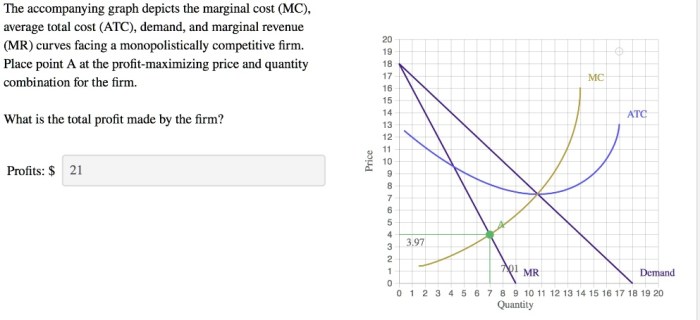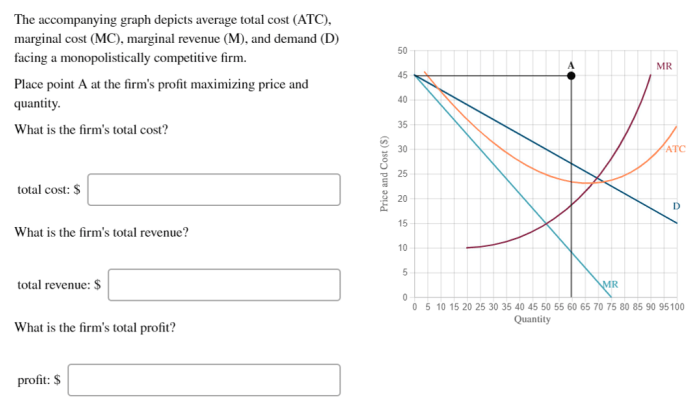The accompanying graph depicts the demand and marginal revenue curves, two fundamental concepts in economics that provide valuable insights into consumer behavior and revenue optimization. This exploration will delve into the definitions, relationships, and practical applications of these curves, equipping readers with a comprehensive understanding of their significance in economic decision-making.
The demand curve illustrates the inverse relationship between price and quantity demanded, while the marginal revenue curve captures the change in total revenue resulting from a one-unit increase in output. Together, these curves provide a graphical representation of the interplay between consumer preferences and revenue generation.
Demand Curve

The demand curve is a graphical representation of the relationship between the price of a good or service and the quantity demanded. The law of demand states that, ceteris paribus, as the price of a good or service increases, the quantity demanded will decrease, and vice versa.
The demand curve is typically downward sloping, reflecting the inverse relationship between price and quantity demanded. This relationship can be illustrated using the following table:
| Price | Quantity Demanded |
|---|---|
| $10 | 100 |
| $8 | 120 |
| $6 | 140 |
| $4 | 160 |
| $2 | 180 |
Marginal Revenue Curve

Marginal revenue is the additional revenue generated by selling one additional unit of a good or service. The marginal revenue curve is a graphical representation of the relationship between the quantity of a good or service sold and the marginal revenue generated.
The marginal revenue curve is typically downward sloping, reflecting the diminishing marginal revenue generated by selling additional units. This relationship can be illustrated using the following table:
| Quantity | Marginal Revenue |
|---|---|
| 100 | $10 |
| 110 | $9 |
| 120 | $8 |
| 130 | $7 |
| 140 | $6 |
The Relationship between Demand and Marginal Revenue

The demand curve and marginal revenue curve are closely related. The marginal revenue curve is the derivative of the demand curve. This means that the slope of the demand curve at any given point is equal to the marginal revenue at that point.
The relationship between demand and marginal revenue can be used to determine the optimal price and quantity for a good or service. The optimal price is the price that maximizes total revenue. The optimal quantity is the quantity that maximizes marginal revenue.
Applications of the Demand and Marginal Revenue Curves: The Accompanying Graph Depicts The Demand And Marginal Revenue
The demand and marginal revenue curves can be used to analyze a variety of market conditions. For example, the demand and marginal revenue curves can be used to:
- Determine the optimal price and quantity for a good or service.
- Analyze the impact of changes in market conditions, such as changes in consumer preferences or changes in the cost of production.
- Make predictions about the behavior of consumers and producers.
FAQ Guide
What is the law of demand?
The law of demand states that as the price of a good or service increases, the quantity demanded decreases, assuming other factors remain constant.
How is marginal revenue related to demand?
Marginal revenue is the additional revenue generated from selling one more unit of output. It is directly related to demand, as a higher demand for a product will lead to a higher marginal revenue.
How can the demand and marginal revenue curves be used in decision-making?
Businesses can use these curves to determine the optimal price and quantity to produce, as the point where marginal revenue equals marginal cost represents the profit-maximizing output level.